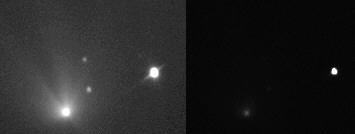
Proof #1 - What I Imaged Was Far Brighter than an 8th or 9th Magitude Star

The picture on the left is the original image I released on the internet. It's made up of 12 exposures of 3 seconds each electronically overlayed on top of each other to reduce noise and make a cleaner image. The image on the right is the very same composite picture only the gray levels are processed differently to bring out differences in brightness between the comet nucleus and the "companion." They are processed in a "linear" manner and not "stretched" in anyway to artificially enhance brightness differences. The "companion" is at least ten times brighter than the nucleus of the comet. If I had imaged the star that so many "astronomers" say I had then the brightnesses would have been about the same. As you can easily see, the "companion" is still a fully saturated "white" while the comet almost fades to invisibility. This comparison clearly shows the "companion" is conservatively 10 to 20 times brighter than the nucleus of the comet.
Proof #2 - Bright Star Images Grow and Expand During Longer Exposures

To those who claim the image of the "companion" is merely a bright star which expanded because of the exposure time I offer the following pictures. On the night of November 14, I imaged over 160 images of the comet and its "companion." The exposures ranged from 1 to 5 seconds. I like short exposures because they lessen the chance of bright stars blooming or expanding on the image. The top picture was a 1 second exposure, the bottom was a 5 second exposure. A bright star would have grown in size greatly between these two exposures but this did not happen. Except for a better view of the dimmer "edge" of the "companion" the images are the same size. Also note the "rings" or "spikes" are about the same size, showing they are not some anomaly in the imaging system due to exposure timing.